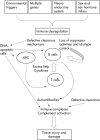Pathogenesis of systemic lupus erythematosus - PubMed (original) (raw)
Review
Pathogenesis of systemic lupus erythematosus
C C Mok et al. J Clin Pathol. 2003 Jul.
Abstract
The exact patho-aetiology of systemic lupus erythematosus (SLE) remains elusive. An extremely complicated and multifactorial interaction among various genetic and environmental factors is probably involved. Multiple genes contribute to disease susceptibility. The interaction of sex, hormonal milieu, and the hypothalamo-pituitary-adrenal axis modifies this susceptibility and the clinical expression of the disease. Defective immune regulatory mechanisms, such as the clearance of apoptotic cells and immune complexes, are important contributors to the development of SLE. The loss of immune tolerance, increased antigenic load, excess T cell help, defective B cell suppression, and the shifting of T helper 1 (Th1) to Th2 immune responses leads to B cell hyperactivity and the production of pathogenic autoantibodies. Finally, certain environmental factors are probably required to trigger the disease.
Figures
Figure 1
The pathogenesis of systemic lupus erythematosus. APC, antigen presenting cell.
Similar articles
- Specific combinations of HLA-DR2 and DR3 class II haplotypes contribute graded risk for disease susceptibility and autoantibodies in human SLE.
Graham RR, Ortmann W, Rodine P, Espe K, Langefeld C, Lange E, Williams A, Beck S, Kyogoku C, Moser K, Gaffney P, Gregersen PK, Criswell LA, Harley JB, Behrens TW. Graham RR, et al. Eur J Hum Genet. 2007 Aug;15(8):823-30. doi: 10.1038/sj.ejhg.5201827. Epub 2007 Apr 4. Eur J Hum Genet. 2007. PMID: 17406641 - HLA-DR modulates autoantibody repertoire, but not mortality, in a humanized mouse model of systemic lupus erythematosus.
Paisansinsup T, Vallejo AN, Luthra H, David CS. Paisansinsup T, et al. J Immunol. 2001 Oct 1;167(7):4083-90. doi: 10.4049/jimmunol.167.7.4083. J Immunol. 2001. PMID: 11564830 - [Pathogenesis of systemic lupus erythematosus].
Alexander T, Radbruch A, Hiepe F. Alexander T, et al. Z Rheumatol. 2015 Apr;74(3):183-90. doi: 10.1007/s00393-014-1456-2. Z Rheumatol. 2015. PMID: 25854151 German. - The pathogenesis of systemic lupus erythematosus.
Childs SG. Childs SG. Orthop Nurs. 2006 Mar-Apr;25(2):140-5; quiz 146-7. doi: 10.1097/00006416-200603000-00013. Orthop Nurs. 2006. PMID: 16572034 Review. - Expanding the B Cell-Centric View of Systemic Lupus Erythematosus.
Morawski PA, Bolland S. Morawski PA, et al. Trends Immunol. 2017 May;38(5):373-382. doi: 10.1016/j.it.2017.02.001. Epub 2017 Mar 6. Trends Immunol. 2017. PMID: 28274696 Free PMC article. Review.
Cited by
- The safety and efficacy of Baricitinib for systemic lupus erythematosus: a systematic review and meta-analysis of randomized controlled trials.
Ramadan A, Gowaily I, Saleh O, Abuelazm M, Ahmad U, Elzeftawy MA, Nathan Ezie K, Abdelazeem B. Ramadan A, et al. Ann Med Surg (Lond). 2024 Sep 5;86(11):6673-6685. doi: 10.1097/MS9.0000000000002548. eCollection 2024 Nov. Ann Med Surg (Lond). 2024. PMID: 39525758 Free PMC article. Review. - The Role of Antioxidant Transcription Factor Nrf2 and Its Activating Compounds in Systemic Lupus Erythematosus.
Liu L, de Leeuw K, van Goor H, Westra J. Liu L, et al. Antioxidants (Basel). 2024 Oct 11;13(10):1224. doi: 10.3390/antiox13101224. Antioxidants (Basel). 2024. PMID: 39456477 Free PMC article. Review. - The 100 top-cited studies in systemic lupus erythematosus: A bibliometric analysis.
Quan L, Dai J, Luo Y, Wang L, Liu Y, Meng J, Yang F, You X. Quan L, et al. Hum Vaccin Immunother. 2024 Dec 31;20(1):2387461. doi: 10.1080/21645515.2024.2387461. Epub 2024 Aug 16. Hum Vaccin Immunother. 2024. PMID: 39149877 Free PMC article. Review. - Evaluation of the Efficacy and Safety of Anifrolumab in Moderate-to-Severe Systemic Lupus Erythematosus.
Cingireddy AR, Ramini N, Cingireddy AR. Cingireddy AR, et al. Cureus. 2024 Jul 6;16(7):e63966. doi: 10.7759/cureus.63966. eCollection 2024 Jul. Cureus. 2024. PMID: 39104974 Free PMC article. Review. - Exploring the Role of Th10 Cells and IL-10 in Systemic Lupus Erythematosus.
Verma S, Shah S, Nanda R, Meher J, Rathore V, Patel S, Mohapatra E. Verma S, et al. Cureus. 2024 Jul 5;16(7):e63875. doi: 10.7759/cureus.63875. eCollection 2024 Jul. Cureus. 2024. PMID: 39099913 Free PMC article.
References
- Pisetsky DS. Systemic lupus erythematosus. A. Epidemiology, pathology and pathogenesis. In: Klippel JH, ed. Primer on the rheumatic diseases, 11th ed. Georgia, USA: Arthritis Foundation, 1997:246–51.
- Walport MJ, Davies KA, Botto M. C1q and systemic lupus erythematosus. Immunobiology 1998;199:265–85. - PubMed
- Schur PH. Genetics of systemic lupus erythematosus. Lupus 1995;4:425–37. - PubMed
- Atkinson JP. Complement activation and complement receptors in systemic lupus erythematosus. Springer Semin Immunopathol 1986;9:179–94. - PubMed
- Sullivan KE. Genetics of systemic lupus erythematosus. Clinical implications. Rheum Dis Clin North Am 2000;26:229–56. - PubMed
Publication types
MeSH terms
Substances
LinkOut - more resources
Full Text Sources
Other Literature Sources
Medical
